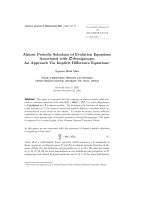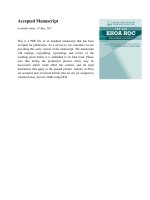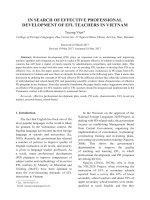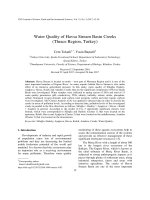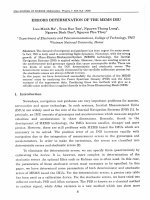DSpace at VNU: Periodic solutions of evolution equations
Bạn đang xem bản rút gọn của tài liệu. Xem và tải ngay bản đầy đủ của tài liệu tại đây (116.99 KB, 7 trang )
Math. Nachr. 278, No. 4, 356 – 362 (2005) / DOI 10.1002/mana.200410245
Anti-periodic solutions for evolution equations with mappings in the
class (S+ )
Yu Qing Chen∗1 , Yeol Je Cho∗∗2 , and Donal O’Regan∗∗∗3
1
2
3
Department of Mathematics, Foshan University, Foshan, Guangdong 528000, P. R. China
Department of Mathematics Education and the RINS, College of Education, Gyeongsang National University,
Chinju 660-701, Korea
Department of Mathematics, National University of Ireland, Galway, Ireland
Received 1 June 2004, accepted 3 September 2004
Published online 31 January 2005
Key words Evolution equation, anti-periodic solution, a mapping of class (S+ )
MSC (2000) Primary: 34C25, 34G20; Secondary: 47H05, 47H10
In this paper, we study the existence of anti-periodic solutions for the first order evolution equation
u (t) + ∂Gu(t) + f (t) = 0 , t ∈ R ,
u(t + T ) = −u(t) ,
t ∈ R,
in a Hilbert space H, where G : H → R is an even function such that ∂G is a mapping of class (S+ ) and
f : R → R satisfies f (t + T ) = −f (t) for any t ∈ R with f (·) ∈ L2 (0, T ; H).
c 2005 WILEY-VCH Verlag GmbH & Co. KGaA, Weinheim
1
Introduction
Okochi [14], [15] initiated the study of anti-periodic solutions for the following nonlinear evolution equation
u (t) + ∂φ(u(t)) f (t) , a. e. t ∈ R ,
u(t + T ) = −u(t) ,
t ∈ R,
(E 1.1)
in Hilbert spaces, where ∂φ is the subdifferential of an even function φ on a real Hilbert space H and f is a
T -anti-periodic function. It was shown in [15], by applying a fixed point theorem for a non-expansive mapping,
that the problem (E 1.1) has a solution. Following Okochi’s work, Haraux [13] proved some existence and
uniqueness theorems for anti-periodic solutions of gradient type equations by using Brouwer’s and Schauder’s
fixed point theorem. Later, Aftabizadeh, Aizicovici and Pavel [1], [2], [3] studied the anti-periodic solutions
for first and second order evolution equations in Hilbert and Banach spaces by using maximal monotone or
m-accretive operator theory. We refer the reader to Aizicovici, MacKibben and Reich [4], Chen, Cho [8], [9],
[12], Souplet [19], [20] for other works on anti-periodic solutions.
In this paper, we will study the existence problems of anti-periodic solution for the first order evolution equation
u (t) + ∂Gu + f (t) = 0 , a. e. t ∈ R ,
u(t + T ) = −u(t) ,
t ∈ R,
(E 1.2)
in a real separable Hilbert space H, where G : H → R is an even function such that ∂G is a mapping of class
(S+ ) and f : R → R satisfies f (t + T ) = −f (t) for t ∈ R and f (·) ∈ L2 (0, T ; H). This equation is still of
gradient type, but we do not require any Lipschitz condition on ∂G which is required in [9] and [13].
∗
∗∗
∗∗∗
e-mail:
Corresponding author: e-mail:
e-mail:
c 2005 WILEY-VCH Verlag GmbH & Co. KGaA, Weinheim
Math. Nachr. 278, No. 4 (2005) / www.mn-journal.com
2
357
The existence results
In this section, assume that H is a real Hilbert space, G : D(G) ⊆ H → R is an even function, and f (t) : R → H
is a function satisfies f (t + T ) = −f (t). Consider the following anti-periodic problem
u (t) + ∂Gu(t) + f (t) = 0 , a. e. t ∈ R ,
u(t) = −u(t + T ) ,
t ∈ R.
(E 2.1)
Definition 2.1 A function u(·) is called a weak anti-periodic solution of the problem (E 2.1) if u(t + T ) =
−u(t) for t ∈ R and the weak derivative u (t) satisfies
u (t) + ∂Gu(t) + f (t) = 0
for almost all t ∈ R.
Lemma 2.2 ([12]) If u, u ∈ L2 (0, T ; H) and u(t + T ) = −u(t) for any t ∈ R, then
|u|∞
√
T
≤
2
T
0
2
|u (s)| ds
1
2
.
In this paper, we shall use different assumptions and different methods from those papers mentioned in Section 1. For completeness, let us recall the definition of mappings in the class (S+ ) in a Hilbert space.
Definition 2.3 Let T : D(T ) ⊆ H → H be a mapping.
x0 and lim supn→∞ (T xn , xn − x0 ) ≤ 0 imply that xn → x0 , then we call T a
(1) If {xn } ⊂ D(T ), xn
mapping of class (S+ ),
(2) T is said to be demi-continuous if xn → x0 implies that T xn
T x0 .
For mappings of class (S+ ) in reflexive Banach spaces and their applications, we refer the reader to [5]–[7],
[9]–[11], [17] and [18].
Theorem 2.4 Let H be a real separable Hilbert space and let G : H → R be even and Fr´echet differentiable.
If ∂G is a demi-continuous bounded mapping of class (S+ ) and f : R → H is in L2 (0, T ; H) and satisfies
f (t + T ) = −f (t) for all t ∈ R, then the equation
u + ∂Gu(t) + f (t) = 0 , a. e. t ∈ R ,
u(t + T ) = −u(t) ,
t ∈ R,
(E 2.2)
has a weak solution.
P r o o f. Since H is separable, there exists an orthogonal basis {e1 , e2 , . . .} of H. Set
Hn = Span {e1 , e2 , . . . , en }
for n = 1, 2, . . . and let Pn : H → Hn be the projection. We consider the equation
u (t) + Pn ∂Gu(t) + Pn f (t) = 0 , a. e. t ∈ R ,
u(t + T ) = −u(t) ,
t ∈ R.
(E 2.3)
For each n = 1, 2, . . . , set
Wn = {u : R → Hn is continuous, u(t + T ) = −u(t)} ,
and
W 1,2
=
n
u ∈ Wn :
T
0
|u (t)|2 dt < ∞ .
c 2005 WILEY-VCH Verlag GmbH & Co. KGaA, Weinheim
358
Chen, Cho, and O’Regan: Anti-periodic solutions for evolution equations
Then Wn is a Banach space under the norm |u|∞ = maxt∈[0,T ] |u(t)|, and we may define a norm on W 1,2
n by
u
W 1,2
T
= |u|∞ +
0
1
2
2
|u (t)| dt
,
where | · | is the norm in H.
For each v(·) ∈ Wn , consider the following equation
u (t) + Pn ∂Gv(t) + Pn f (t) = 0 , a. e. t ∈ R ,
u(t) = −u(t + T ) ,
t ∈ R.
(E 2.4)
It is easy to check that
u(t) = −
t
[Pn ∂Gv(s) + Pn f (s)] ds +
0
T
1
2
0
[Pn ∂Gv(s) + Pn f (s)] ds
is the unique solution of the problem (E 2.4).
Next, we define a mapping L : Wn → Wn as follows: For each v(·) ∈ Wn , Lv is the solution of the problem
(E 2.4).
We prove that L is continuous. Suppose vj (·) ∈ Wn and vj (·) → v0 (·) in Wn . Then |vj (·) − v(·)|∞ → 0 as
j → ∞. Since
(Lvj (t)) − (Lv0 (t)) + (Pn ∂Gvj (t) − Pn ∂Gv0 (t)) = 0 ,
a. e. t ∈ R ,
(2.1)
if we multiply both sides of (2.1) by (Lvj (t) − Lv0 (t)) and integrate over (0, T ), we get
T
0
T
|(Lvj (t) − Lv0 (t)) |2 dt +
0
(Pn ∂Gvj (t) − Pn ∂Gv0 (t))(Lvj (t) − Lv0 (t)) ) dt = 0 .
Since Pn ∂G is continuous in Hn , we have
T
0
1
2
2
|(Lvj (t) − Lv0 (t)) | dt
≤
√
T |Pn ∂Gvj (·) − Pn ∂Gv0 (·)|∞ −→ 0
as j −→ ∞ .
This with Lemma 2.2 guarantees that L is continuous. For each v(·) ∈ Wn , again by the problem (E 2.4), we get
T
0
T
|(Lv(t)) |2 dt +
0
T
(Pn ∂Gv(t), (Lv(t)) ) dt +
0
(Pn f (t), (Lv(t)) ) dt = 0 .
Thus it follows that
T
0
1
2
2
|(Lv(t)) | dt
≤
T
0
2
|Pn Gv(t)| dt
1
2
T
+
0
2
|f (t)| dt
1
2
(2.2)
.
From (2.2), the continuity of Pn ∂G in Hn and Lemma 2.2, we know that L maps bounded sets of Wn to bounded
1,2
sets in Wn . The compact embedding of W 1,2
n into Wn together with L : Wn → W n continuous guarantees that
L : Wn → Wn is a compact mapping.
Now, we prove that Lv(·) = λv(·) for v(·) ∈ Wn with
√
|v(·)|∞ >
T
2
T
0
|f (t)|2 dt
and λ ≥ 1. If this is not true, then there exist λ0 ≥ 1, v0 (·) ∈ Wn with |v(·)|∞ >
√
T
2
T
0
|f (t)|2 dt
1
2
such that
Lv0 (·) = λ0 v0 (·), i.e.,
λ0 v0 (t) + Pn ∂Gv0 (t) + Pn f (t) = 0 .
(2.3)
c 2005 WILEY-VCH Verlag GmbH & Co. KGaA, Weinheim
Math. Nachr. 278, No. 4 (2005) / www.mn-journal.com
359
Multiply both sides of (2.3) by v0 (t) and integrate over [0, T ] to obtain
T
(2.4)
(λ0 v0 (t) + Pn ∂Gv0 (t) + Pn f (t), v0 (t)) dt = 0 .
0
Notice that
T
T
(Pn ∂Gv0 (t), v0 (t)) dt =
0
(∂Gv0 (t), v0 (t)) dt = 0
0
and so we have
T
0
T
|v0 (t)|2 dt ≤
0
1
2
|f (t)|2 dt
,
which implies from Lemma 2.2 that
√
|v(·)|∞ ≤
which is a contradiction.
T
2
√
T
0
1
2
|f (t)|2 dt
T
Now, if we take r0 > 2T 0 |f (t)|2 dt
the Leray-Schauder degree, we know that
,
1
2
, by the above argument and the homotopy invariance property of
deg(I − L, B(0, r0 ), 0) = deg(I, B(0, r0 ), 0) = 1 ,
where B(0, r0 ) is the open ball centered at 0 with radius r0 in Wn . Therefore, L has a fixed point in B(0, r0 ),
i.e., there exists vn (·) ∈ Wn such that Lvn (·) = vn (·). Hence problem (E 2.3) has a solution vn (·).
It is easy to show that
T
0
|vn
(t)|2
T
dt ≤
0
2
|Pn f (t)| dt
1
2
(2.5)
.
From (2.5) and Lemma 2.2, it follows that
|vn (·)|∞
√
T
≤
2
T
0
2
|Pn f (t)| dt
1
2
(2.6)
.
From (2.5), we may assume that vk (·)
y(·) ∈ L2 (0, T ; H) and, in view of (2.6), we may also assume that
t
vn (0)
v0 ∈ H (otherwise, take a subsequence). Since vn (t) = vn (0)+ 0 vn (s) ds, we have vn (t)
v0 (t) =
t
t
v0 + 0 y(s) ds, where 0 y(s) ds is the weak integral.
Multiply (E 2.3) by vn (t) − v0 (t) and integrate over [0, T ] to get
T
0
[(vn (t), vn (t) − v0 (t)) + (∂Gvn (t), vn (t) − Pn v0 (t)) + (Pn f (t), vn (t) − v0 (t))] dt = 0 .
Let n → ∞ to obtain
T
lim
n→∞
0
(∂Gvn (t), vn (t) − Pn v0 (t)) dt = 0 .
We claim that limn→∞
T
(∂Gvn (t), v0 (t)
0
− Pn v0 (t)) dt = 0. In fact, we have
|(∂Gvn (t), v0 (t) − Pn v0 (t))| ≤ |∂Gvn (t)||v0 (t) − Pn v0 (t)| −→ 0
as n −→ ∞
c 2005 WILEY-VCH Verlag GmbH & Co. KGaA, Weinheim
360
Chen, Cho, and O’Regan: Anti-periodic solutions for evolution equations
for t ∈ [0, T ], and it follows from (2.6) and the boundedness of ∂G that |∂Gvn (t)||v0 (t) − Pn v0 (t)| is bounded
by some integrable function, thus by Lebesgue’s dominated convergence theorem it follows that
T
lim
n→∞
0
(∂Gvn (t), v0 (t) − Pn v0 (t)) dt = 0 .
Thus we have
T
lim
n→∞
0
(∂Gvn (t), vn (t) − v0 (t)) dt = 0 .
(2.7)
However ∂G is a mapping of class (S+ ), and we claim that
lim inf (∂Gvn (t), vn (t) − v0 (t)) ≥ 0 ,
n→∞
t ∈ [0, T ] .
Assume that it is false. Then there exists t0 ∈ [0, T ] such that
lim inf (∂Gvn (t0 ), vn (t0 ) − v0 (t0 )) < 0 ,
n→∞
but ∂G is a mapping of class (S+ ), so we have vn (t0 ) → v0 (t0 ), and this with the demi-continuity of ∂G implies
that
(∂Gvn (t0 ), vn (t0 ) − v0 (t0 )) −→ 0 as
n → ∞,
which is a contradiction. This and (2.7) imply that {(∂Gvn (t), vn (t)−v0 (t))}∞
n=1 converges to zero in measure as
∞
n → ∞ and so {(∂Gvn (t), vn (t) − v0 (t))}∞
n=1 has a subsequence {(∂Gvnk (t), vnk (t) − v0 (t))}k=1 converging
to zero as k → ∞ for almost all t ∈ [0, T ]. Since ∂G is a mapping of class (S+ ), we get vnk (t) → v0 (t) for
almost all t ∈ [0, T ].
From the demi-continuity of ∂G, we have ∂Gvnk (t)
∂Gv0 (t) for almost all t ∈ [0, T ]. It is obvious that
the weak derivative v0 (t) = ∂Gv0 (t) + f (t). Therefore, equation (E 2.2) has a weak solution.
3
An example
In this section, we give an application of our results to anti-periodic solutions for partial differential equations.
Example 3.1 Let a : R → R be a function satisfying the following conditions:
(i) a is continuous and |a (x)| ≤ L |x| + C for x ∈ R, where L > 0, C > 0 are constants,
(ii) (a (x) − a (y))(x − y) ≥ α(x − y)2 for x, y ∈ R, where α > 0 is a constant.
Consider the anti-periodic problem
⎧
3
4
⎪
⎨ut (t, x) = a (ux (t, x))uxx (t, x) + (1 + x ) sin t ,
(E 3.1)
u(t + π, x) = −u(t, x) ,
⎪
⎩
u(t, 0) = 0 , u(t, 1) = 0
for any (t, x) ∈ R × (0, 1) and t ∈ R. We call u(t, x) as a generalized solution of (E 3.1) if u(t + π) = −u(t)
and
1
0
for all v(·) ∈
Put
ut (t, x)v(x) dx = −
H01 ((0, 1))
G(u) =
1
2
1
0
1
a (ux (t, x))v (x) +
0
(1 + x4 ) sin3 tv(x) dx
and almost all t ∈ R.
1
0
|a(u (x))|2 dx
for u(·) ∈ H01 ((0, 1))
and
c 2005 WILEY-VCH Verlag GmbH & Co. KGaA, Weinheim
Math. Nachr. 278, No. 4 (2005) / www.mn-journal.com
f (t, x) = 1 + x4 sin3 t,
361
(t, x) ∈ R × (0, 1) .
Then it is easy to check that
1
(∂Gu, v) =
0
a (u (x))v (x) dx ,
u(·), v(·) ∈ H01 ((0, 1)) .
(3.1)
From assumption (i) and (3.1), we know that ∂G is continuous and bounded on H01 ((0, 1)) and it is obvious that
f (t + π, x) = −f (t, x) for any (t, x) ∈ R × (0, 1). Therefore, (E 3.1) is equivalent to
u (t) = −∂Gu(t) + f (t, ·) , t ∈ R ,
u(t + π) = −u(t) ,
t ∈ R.
(E 3.2)
Next, we check that ∂G is a mapping of class (S+ ) on H01 (Ω). Assume that un
lim supn→∞ (∂Gun , un − u0 ) ≤ 0. Then we have
1
lim sup
n→∞
0
u0 in H01 ((0, 1)) and
a (un (x))(un (x) − u0 (x)) dx ≤ 0 .
From assumption (ii), we know that
1
lim sup
n→∞
0
α |un (x) − u0 (x)|2 dx ≤ 0
and thus un → u0 in H01 ((0, 1)), as desired. From Theorem 2.4, we know that (E 3.2) has a solution and so
(E 3.1) has a solution.
Acknowledgements
The second author was supported from the Korea Research Foundation Grant (KRF-2003-002-C00018).
References
[1] A. R. Aftabizadeh, S. Aizicovici, and N. H. Pavel, On a class of second-order anti-periodic boundary value problems,
J. Math. Anal. Appl. 171, 301–320 (1992).
[2] A. R. Aftabizadeh, S. Aizicovici, and N. H. Pavel, Anti-periodic boundary value problems for higher order differential
equations in Hilbert spaces, Nonlinear Anal. 18, 253–267 (1992).
[3] S. Aizicovici and N. H. Pavel, Anti-periodic solutions to a class of nonlinear differential equations in Hilbert spaces,
J. Funct. Anal. 99, 387–408 (1991).
[4] S. Aizicovici, M. McKibben, and S. Reich, Anti-periodic solutions to monotone evolution equations with discontinuous
nonlinearities, Nonlinear Anal. 43, 233–251 (2001).
[5] F. E. Browder, Nonlinear Operators and Nonlinear Equations of Evolution in Banach Spaces, Proc. Symp. Pure Math.
18, Part 2 (Amer. Math. Soc., Providence, R.I., 1976).
[6] S. S. Chang, Y. Q. Chen, and B. S. Lee, Some existence theorems for differential inclusions in Hilbert spaces, Bull.
Austral. Math. Soc. 54, 317–327 (1996).
[7] S. S. Chang, Y. Q. Chen, K. K. Tan, and X. Z. Yuan, On the existence of periodic solutions for nonlinear evolutions in
Hilbert spaces, Nonlinear Anal. 44, 1019–1029 (2001).
[8] Y. Q. Chen, Note on Massera’s theorem on anti-periodic solution, Advances in Math. Sci. and Appl. 9, 125–128 (1999).
[9] Y. Q. Chen and Y. J. Cho, Anti-periodic solutions for semilinear evolution equations, J. Concrete and Appl. Math. 1,
113–124 (2003).
[10] Y. Q. Chen, Y. J. Cho, and L. Yang, Periodic solutions for nonlinear evolution equations, Dynamic. Cont. Discr. Impul.
Systems 9, 581–598 (2002).
[11] Y. Q. Chen and J. K. Kim, Existence of periodic solutions for first-order evolution equations without coercivity, J. Math.
Anal. Appl. 282, 801–815 (2003).
[12] Y. Q. Chen, X. D. Wang, and H. X. Xu, Anti-periodic solutions for semilinear evolution equations, J. Math. Anal. Appl.
273, 627–636 (2002).
[13] A. Haraux, Anti-periodic solutions of some nonlinear evolution equations, Manuscripta Math. 63, 479–505 (1989).
c 2005 WILEY-VCH Verlag GmbH & Co. KGaA, Weinheim
362
Chen, Cho, and O’Regan: Anti-periodic solutions for evolution equations
[14] H. Okochi, On the existence of periodic solutions to nonlinear abstract parabolic equations, J. Math. Soc. Japan 40,
541–553 (1988).
[15] H. Okochi, On the existence of anti-periodic solutions to a nonlinear evolution equation associated with odd subdifferential operators, J. Funct. Anal. 91, 246–258 (1990).
[16] H. Okochi, On the existence of anti-periodic solutions to nonlinear parabolic equations in noncylindrical domains,
Nonlinear Anal. 14, 771–783 (1990).
[17] D. Pascali and S. Sburlan, Nonlinear Mappings of Monotone Type, Noordhoff, Leyden, 1978.
[18] W. V. Petryshyn, Antipodes theorems for A-proper mappings of the modified type (S) or (S)+ and to mappings with
the Pm property, J. Funct. Anal. 71, 165–211 (1971).
[19] P. Souplet, Uniqueness and nonuniqueness results for the antiperiodic solutions of some second-order nonlinear evolution equations, Nonlinear Anal. 26, 1511–1525 (1996).
[20] P. Souplet, Optimal uniqueness condition for the antiperiodic solutions of some nonlinear parabolic equations, Nonlinear
Anal. 32, 279–286 (1998).
c 2005 WILEY-VCH Verlag GmbH & Co. KGaA, Weinheim
